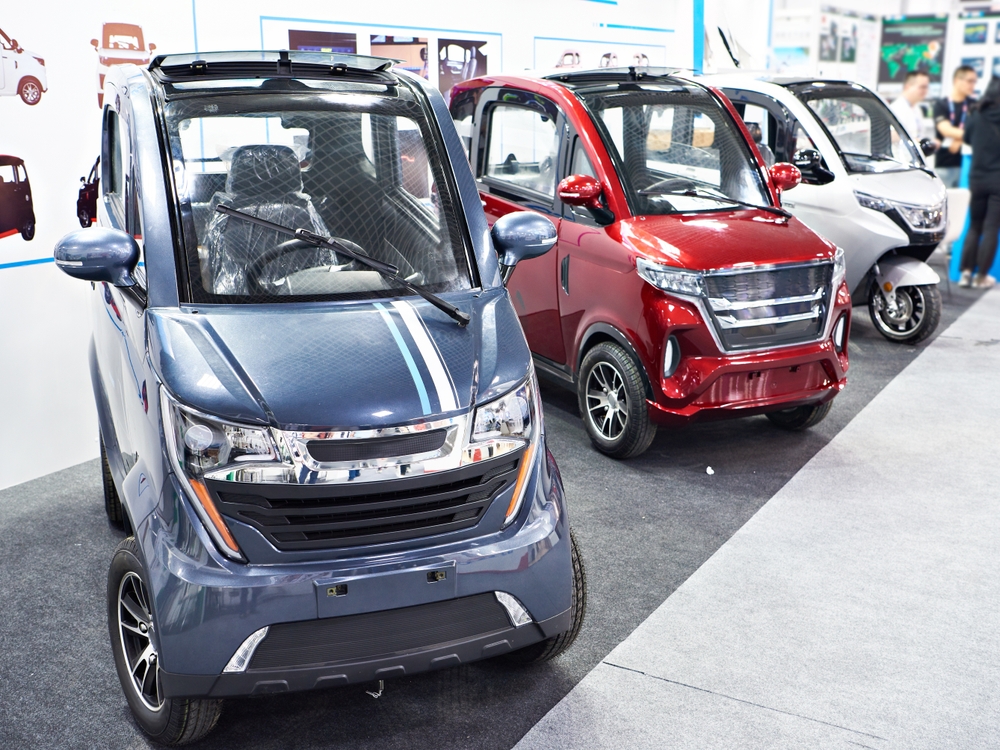VinFast is toying with the idea of selling its diminutive VF 3 electric city car in America. Its dealers completely approve.
Last June, VinFast introduced the VF 3 — a boxy two-door electric vehicle designed to appeal to customers in its home market. In a press release at the time, the company said, “the VF 3 offers numerous benefits, making it suitable for a wide range of applications and operating environments. This eco-friendly vehicle is also equipped with smart features, providing a dynamic mobility option for individuals of all backgrounds.”
The VF 3 has an overall length of 3,114 mm (10.2 feet). It has two doors, seats for five people, 16-inch wheels, and a trunk in the rear. “The body is compact yet tall and robust, providing ample ground clearance. The exterior design is characterized by bold geometric blocks and strong lines that run consistently from the front to the back, creating an eye-catching appearance.” For the sake of comparison, the VF 3 is 2 feet shorter than a Miata.
“With the aim of bringing a model which is for everyone, VinFast VF 3 will offer consumers a range of color options to choose from, further enhancing its customization possibilities. Regarding the interior, the VF 3 is designed to be minimalist to optimize the space for five people to sit inside the car. Basic smart features are fully integrated, ensuring a comfortable and convenient user experience.
“The car is equipped with an electric motor and battery that offer an impressive travel distance, catering to the needs and daily usage patterns of most Vietnamese drivers. It is expected that VinFast will begin accepting VF 3 orders in September 2023 and deliver in Q3 2024.”
The VF 3 will be available in two trim levels — Eco and Plus. It will be priced for mass appeal while providing a safe, convenient, and smart transportation solution. “With its outstanding advantages of zero emissions, noise-free operation, environmental friendliness, and, most importantly, high safety standards, VF 3 has the potential to become the new ‘national vehicle’ for the Vietnamese people. It can help fulfill the car dreams of millions of families while improving living standards and serving as a powerful catalyst for the widespread adoption of electric cars in Vietnam.”
The VinFast VF3 As Vietnamese Beetle
Think of it as the Volkswagen Beetle for Vietnam. Then think back to the original Beetle and recall what that car did for the German auto industry. That’s what a group of prospective VinFast dealers were thinking when they previewed the VF 3 recently. According to Automotive News (paywall), after meeting with dealers, VinFast said it is “researching the demand and potential for the VF 3 model in the US. Further details will be announced in due course.”
Autoblog says it knows what got those dealers all jiggly. Profits! The three most important words in sales are “the price, the price, and the price.” The VF 3 retails for around $12,200 in its home country. What would it sell for in the US? That’s the question that is keeping those dealers awake at night as visions of sugar plums dance in their heads. It certainly would sell for less than $20,000 and potentially quite a bit less.
An American adviser to VinFast told Automotive News that after surveying roughly 100 dealers who attended one meeting, “They liked the whole lineup but the VF 3, I would say, got an almost 100 percent response. They really liked the VF 3 and the reason is it’s probably sub-$20,000.”
Manufactured In The US?
But wait. What if it is manufactured in the US at the new VinFast factory in North Carolina? The first phase of the factory will support an annual production of 150,000 vehicles at full capacity. It will produce both the VinFast VF 8 and its larger sibling, the 7-passenger VF 9. And what if the batteries for the VF 3 are sourced so they meet the requirements of the Inflation Reduction Act? Then you have an electric car that — if you close your eyes and wish real hard — could cost American drivers less than $10,000 to own.
Now let’s not let our imaginations run away with us. First that factory has to be completed and actually start production. Then the dealer network has to come together. Then Americans would have to decide that an inexpensive city car with (probably) around 100 miles of range would meet their needs. As someone who started my electric car journey with a used Nissan LEAF which had a maximum range of 85 miles on a good day going downhill with a tailwind, I can attest that it is possible to drive an electric car with limited range, provided you have access to overnight charging on a regular basis.
Suzuki Led The Way
That’s a lot or “what ifs” and “maybes” that have to become reality first. And as my old Irish grandmother liked to say, “There’s many a slip ‘twixt the cup and the lip.” But still it could happen, and if it all comes together, VinFast could have a hit on its hands that Americans have not seen since the Suzuki Jimny took America by storm.
While traditional manufacturers were pushing large ground-pounding off-road vehicles, Suzuki offered the opposite. Was it a good vehicle? For the price, it was. People loved being able to take one off-road and bash around a bit. It was the closest thing to a mechanical mule since the World War II-era jeep.
There are other historical lessons here. The Yugo sold like hotcakes when it was first introduced. Was it a good car? Not really, but it was cheap and could handle a fair amount of abuse without complaint. Early offerings from Hyundai were also cheap, which followed the pattern set by Toyota and Honda in the 50s. Subaru started out with this marketing slogan — “Inexpensive and built to stay that way.” The early cars were ugly, but affordable, which is what plenty of customers wanted.
The success of the VinFast VF 3 in America will depend entirely on price. If it is cheap enough, buyers will overlook its shortcomings. But if it starts encroaching on other larger vehicles with more range, they will not. What the VF3 really represents is a glimpse of what could happen if Chinese manufacturers decided to set up factories in the US and source their battery materials and components from approved sources.
For the moment, the Chinese know how to build cars cheaper than anyone else. Ultimately, the IRA might bring Chinese cars to America in a way no one — especially Joe Manchin — expected. Buckle up. The EV revolution might get a little bit bumpy going forward.






